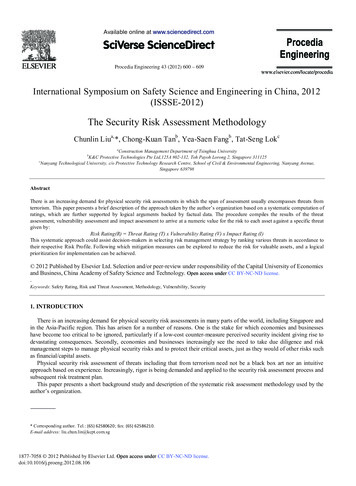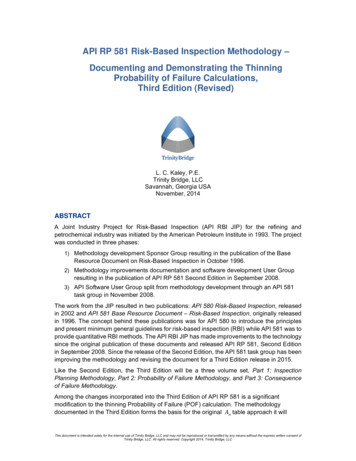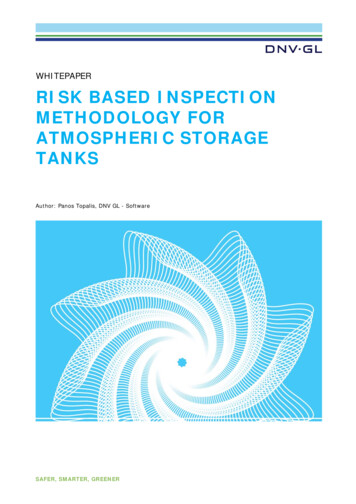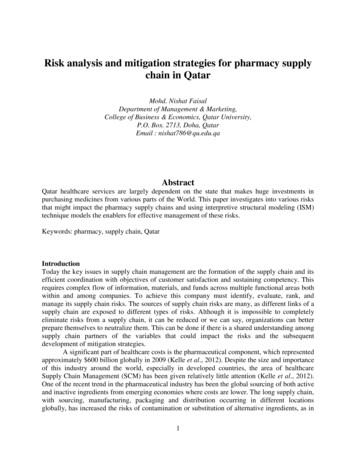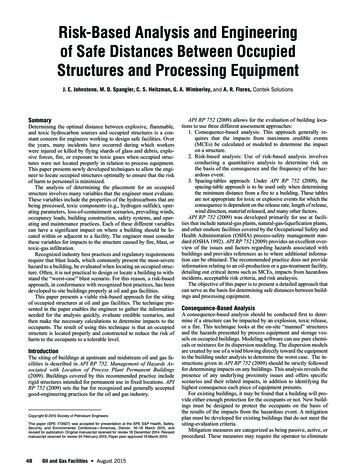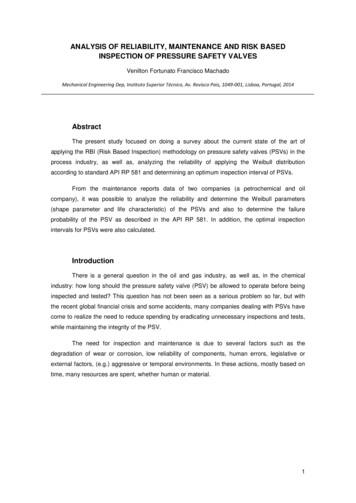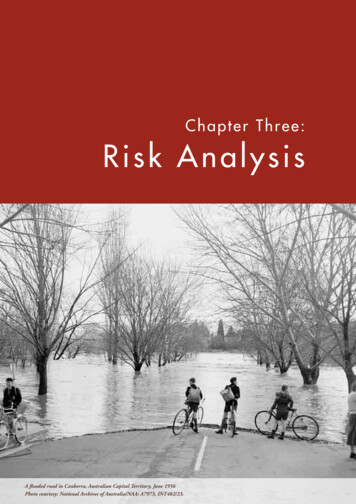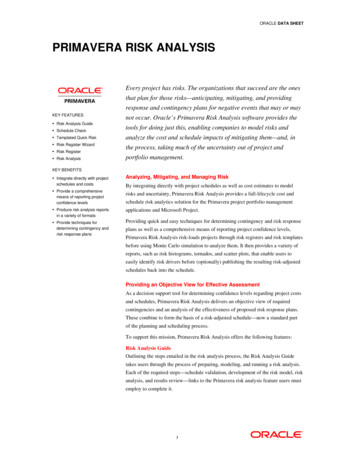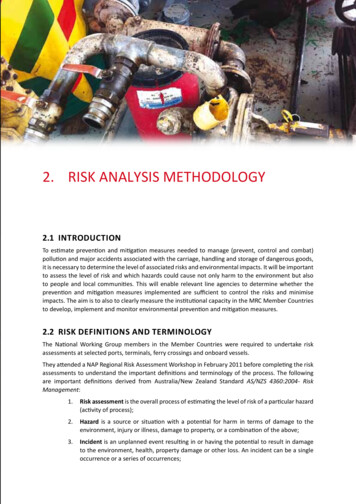
Transcription
Sustainable Management of the Carriage, Handling and Storage of Dangerous Goods along the Mekong River Final report152. RISK ANALYSIS METHODOLOGY2.1 IntroductionTo estimate prevention and mitigation measures needed to manage (prevent, control and combat)pollution and major accidents associated with the carriage, handling and storage of dangerous goods,it is necessary to determine the level of associated risks and environmental impacts. It will be importantto assess the level of risk and which hazards could cause not only harm to the environment but alsoto people and local communities. This will enable relevant line agencies to determine whether theprevention and mitigation measures implemented are sufficient to control the risks and minimiseimpacts. The aim is to also to clearly measure the institutional capacity in the MRC Member Countriesto develop, implement and monitor environmental prevention and mitigation measures.2.2 Risk Definitions and TerminologyThe National Working Group members in the Member Countries were required to undertake riskassessments at selected ports, terminals, ferry crossings and onboard vessels.They attended a NAP Regional Risk Assessment Workshop in February 2011 before completing the riskassessments to understand the important definitions and terminology of the process. The followingare important definitions derived from Australia/New Zealand Standard AS/NZS 4360:2004- RiskManagement:1. Risk assessment is the overall process of estimating the level of risk of a particular hazard(activity of process);2. Hazard is a source or situation with a potential for harm in terms of damage to theenvironment, injury or illness, damage to property, or a combination of the above;3. Incident is an unplanned event resulting in or having the potential to result in damageto the environment, health, property damage or other loss. An incident can be a singleoccurrence or a series of occurrences;
16Risk analysis4. Risk is measured in terms of a combination of the consequences of an incident and theirlikelihood;5. Likelihood is the probability of occurrence;6. Consequence is the severity of an outcome or incident;7. Risk control is measures that eliminate or reduce the risks, associated with the identifiedhazards, as far as practicable;8. Risk evaluation is the process of comparing the level of risk against risk criteria; and9. Risk analysis is the systematic process to understand the nature of and to reduce thelevel of risk. The risk analysis details the likelihood and consequence of an incidentoccurring and investigate the effectiveness of existing risk control measures th at havebeen implemented to reduce and control risks or minimise environmental impacts anddetermine further prevention and mitigation measures that need to be and implemented.Prevention and mitigation measures consider the physical and operational means bywhich the risks are mitigated.10. Prevention measures lower the probability of a scenario occurring. Determines how wellthe environmental risk is currently being controlled and what further action is needed toimprove risk reduction strategies; and11. Mitigation measures lower the severity of the consequences. Assesses the effectivenessof the current emergency measures in place and what further action is needed to improveemergency planning and response strategies.Risks were identified for all processes, activities, products and services associated with the carriage,handling and storage of dangerous goods in the MRC Member Countries. The following section explainsthe methodology used.2.3 Risk Assessment ProcessThe preparation of a risk assessment is a critical element in the risk analysis of dangerous goods. Figure4 on the next page illustrates this process of identifying hazards, and evaluating and controlling risks.Risks must be identified for all processes, activities, products and services associated with the carriage,handling and storage of dangerous goods. Unfortunately, in some of the MRC Member Countries, arisk assessment has not been completed before. There are limited operational, legal or regulatoryframeworks available and records of accidents, to determine the cause and severity of incidents, arealso limited. This Risk Assessment is therefore an important step to determine the baseline conditionsof the transportation of dangerous and priorities areas for improvement.The transport of dangerous goods chain encompasses a wide range of systems including storage ofdangerous goods and hazardous substances, handling and transportation, and waste disposal. Thetransport and storage of dangerous goods involves many elements in complex, interdependent anddynamic relationships. The system consists of objects of transport (goods and people), technical meansof vessel, port/terminal infrastructure and facilities, management and operations, documentationand human resources. Human factors are very important to evaluate in the system since they design,develop, build, operate, manage, regulate and interact with other elements of the system.
Risk analysis methodology17Dangerous goods in bulk and packaged dangerous goods are carried onboard different types of vesselsincluding tankers, general cargo vessels and ferries. The common practice is that different regulationsapply for different vessels. At this stage, however, the study tried to look at the most critical activities andoperations onboard. A similar approach was taken for ports and terminals where petroleum terminals,ports and floating fuel stations are primarily used for the storing and handling dangerous goods forthe domestic and international trade of petroleum products. This study prepared a comprehensiverisk assessment that covered all the critical activities and operations, possible hazards, consequencesto evaluate the risks for vessels, ports and terminals. The risk assessment specifically focussed onthe activities and operations involved with the transport of dangerous goods in the MRC MemberCountries. The following sections provide an overview of dangerous goods and the associated risks.Figure 4: Risk Management Process2.4 Dangerous GoodsDangerous goods may be explosive, flammable, combustible, spontaneously combustible, oxidising,water-reactive, toxic or corrosive (see Annex 1). They can be deadly and seriously damage property andthe environment so it is important that they are stored and handled safely.2.4.1 Definitions and TerminologyDangerous goods are classified on the basis of immediate physical or chemical effects, such as fire,explosion, corrosion and poisoning affecting property, the environment or people. The InternationalMaritime Dangerous Goods (IMDG) Code classifies dangerous goods in different classes, subdivides anumber of these classes and defines and describes characteristics and properties of the substances,material and articles within each class or division. These classes or divisions are as listed below in Table2.
18Risk analysisTable 2: IMDG Code Dangerous Goods Class or DivisionsClassSymbolDescription1Explosive substances and articles2Gases2.1: Flammable gases2.2: Non-flammable, non-toxic gases2.3: Toxic gases3Flammable liquids4.1Flammable solids, self-reactivesubstances and desensitised explosives4.2Substances liable to spontaneouscombustion4.3Substances which, in contact with water,emit flammable gases5.1Oxidising substances5.2Organic peroxides6.1Toxic substances6.2Infectious substances7Radioactive material8Corrosive substances9Miscellaneous dangerous substancesand articlesMany of the substances assigned to Classes 1 to 9 are deemed as marine pollutants. Certain marinepollutants have an extreme pollution potential and are identified as severe marine pollutants. Thesepollutants will also have an impact on the Mekong River and have been included in the Risk Analysis. Itis important to consider the physical and chemical properties of dangerous goods to determine the riskassociated with storage and handling. Table 3 below shows the intrinsic properties of the dangerousgoods classes.
Risk analysis methodology19Table 3: Intrinsic Hazardous Properties of Dangerous GoodsHazardClass/Division (including tyChemical explosionPhysical explosionPhysical and chemical explosionExplosive atmosphereToxic by inhalationToxic by skin/eye contactToxic by ingestionTemperature sensitivityAsphyxiation riskCorrosivenessHigh reactivityChemical instabilityHazardous decompositionEnvironmental pollutantThe IMDG Code is incorporated into rules and regulations for maritime, rail road and inland watertransport. The following international standards have adopted the IMDG Code for inland navigation: ADN Regulations 2009: European Agreement concerning the carriage ofdangerous goods; International Safety Guide for Inland Navigation Tanker Barges and Terminals; and Recommendations on the Safe Transport of Dangerous Cargoes and Related Activities inPort Areas, IMO, 1995.It is especially important in ports and terminals to ensure that different classes of dangerous goods aresegregated to ensure that incompatible substances are not stored together.
20Risk analysis2.4.2 Incompatible GoodsTwo or more goods are incompatible provided their interaction gives rise to any of the followingoutcomes: harm to persons, property or the environment; fire, or explosion, generation of toxic, flammable or corrosive vapours/gases; accelerate the combustion of other goods/liquids in the event of fire; release of the contents results in the premature degradation/corrosion of other dangerousgoods or combustible liquids' packaging/means of containment; and in the event of a fire/spill/release, the interaction of dangerous goods/combustible liquidswith incompatible firefighting or dispersal media. Some materials are water reactive andshould be stored away from other goods that are reliant on water or foam as a firefighting/dispersal/suppression media).A compatibility chart is used to ensure that incompatible dangerous goods are segregated andadequately stored according to class (Table 4).Table 4: Example of Compatibility Chart for Dangerous GoodsClass ofGoods2.12.12.2 BS1 A2.2B2.2S1SR 5.1 S12.3 S23 S24.1 S44.24.3 5.2B S1 S2 S2 S4 S5S5 S25.1A B 2.2 B2.3 S1 S1 BS1 S1 S2 S2 S4 S5 S2 S2 S4 S5 S2 S2 S2 S2 S2 AS3 S2 S4 S5 S2 S4 4.2 S4 S4 S4 S4 S4 AS4 S4 S5 S2 S4 4.3 S2 S5 S5 S5 S5 S5 S5 S4 S4 CS3S3S4 S5AS55.1B S2 S2 S2 S2 S4 AS5 S5 BS5S38 9CombustibleliquidsS2 C S2C S2CS2BBB S2B S4 CS1BG S5 S4S4S4 S4 S4 S4 C S3BC89 S1S1S1CCCCombustibleLiquids S2 S2 S2CS1 CS2 S3S3S4 S5S5 S1 S4S1B 6.1S4S4S5S55.2DS1C 4.1S16.1 S4 S2 S2S4C S2S2S4B S2IS4S13C BBBS5S3 BBBGC B S2 S4 S5 S3 ECES4CE CS3 CES4CE S4AHB S3HFCS3BABS4 S3 BA
Risk analysis methodology21 May be compatible in many cases with exceptions. Follow the alphabetical compatible goodsguidance notes. Likely to be incompatible. Segregation strongly recommended, follow the segregation of guidancenotes for incompatible goods.S1Segregate these goods by 3 m or more in a well ventilated area. For liquid dangerous goods, thedistance is measured from the edge of the spill catchment area. See supplementary notes 6 and 7.S2Segregate by 5 m or more. If one of the dangerous goods is a liquid, measure the distance from theedge of the spill catchment area. Liquid dangerous goods should be located within a separate spillcatchment area. See supplementary notes 6 and 7.S3Segregate by 3 m or more for PG III goods and 5 m or more for PG II, PG I goods or where the goodsmay react dangerously. If both are solids then a minimum of 1 m separation may be used. Whereone of the goods is a liquid, the distance is measured from the edge of the spill catchment area. Seesupplementary notes 6 and 7.S4Segregation preferred by the use of fire-rated partitioned areas. Consider use of separate detachedbuildings for organic peroxides and for highly pyrophoric class 4.2 goods.S5Segregation of Class 4.3 preferred by use of a separate, detached building without water based firesuppression system.It is important to consider firstly the hazards intrinsic to the dangerous goods. The next step is to alsoidentify hazards that are external to the goods. This includes all other substances, structures, plant,systems of work and activities used in the storage and handling of dangerous goods or not directlyinvolved with dangerous goods but that could impinge on safety and protection of the environment.2.4.3 Risk AssessmentWhen conducting risk assessment for dangerous goods it is important to consider the chemical andphysical properties and the critical activities and operations associated with the storage, handling andtransport.Risk, in relation to dangerous goods to property or the environment, is the probability of dangerousgoods causing unreasonable damage or harm to property or the environment. In relation to people,this is the probability of dangerous goods causing the death or injury to one or more individuals.Risk assessment, in relation to the dangerous goods handled or stored at a port or terminal ortransported by vessel, should be a detailed evaluation that: identifies all hazards relating to dangerous goods at the site; for each hazard, determines the likelihood of the hazard causing a dangerous goodsincident; nature of the harm to people, property and the environment that would result from theoccurrence of that incident; and for each hazard, identifies risk control measures;When preparing a risk assessment for dangerous goods, the following key risk factors were consideredin relation to ports, terminals and vessels: failure of containment leading to spillage or leakage of goods (e.g. failure of tank containingthe goods, including cargo pipes, during transfer from terminal and vessels); fires and explosions resulting from the nature of the dangerous goods;
22Risk analysis storages of combustible l
are important definitions derived from Australia/New Zealand Standard AS/NZS 4360:2004- Risk Management: 1. risk assessment is the overall process of estimating the level of risk of a particular hazard (activity of process); 2. hazard is a source or situation with a potential for harm in terms of damage to the environment, injury or illness, damage to property, or a combination of the above; 3 .
